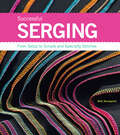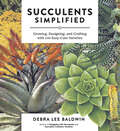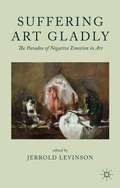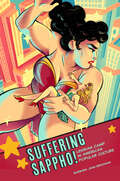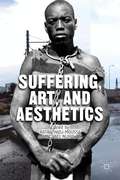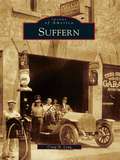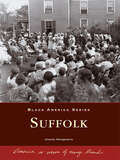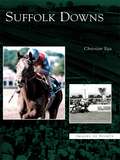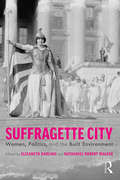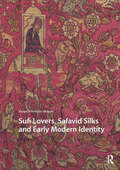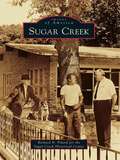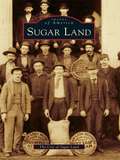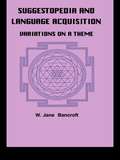- Table View
- List View
Successful Serging: From Setup to Simple and Specialty Stitches
by Beth BaumgartelAn easy-to-use guide to all you need to know about using a serger machine, including thread & stitch selection and stitching & construction techniques.This “at your fingertips” reference contains hundreds of techniques and tips for making the most of the serger, or overlock, machine—a versatile and speedy tool for stitching garments and home decor.Readers will learn how the serger works, the many styles available, and the variety of functional and decorative stitches possible. There are also easy-to-find-and-follow charts—of thread choices, must-have accessories, and best stitches for a range of fabric types. This book is an easy-reference collection of basic techniques, tips, and helpful information for anyone who is learning about or already owns a serger.
Successful Sewing
by Mary G. WestfallTextbook designed for use by beginning and experienced sewing students.
Succulents Simplified: Growing, Designing, and Crafting with 100 Easy-Care Varieties
by Debra Lee BaldwinSucculents are hot. And Debra Lee Baldwin, the bestselling author of Designing with Succulents and Succulent Container Gardens, is the ideal guide for gardeners, crafters, and DIYers looking for an introduction to these trendy, low-maintenance, drought-tolerant plants. Along with gorgeous photos packed with design ideas, Debra offers her top 100 plant picks and explains how to grow and care for succulents no matter where you live. Step-by-step projects, including a cake-stand centerpiece, special-occasion bouquets, a vertical garden, and a succulent topiary sphere, will inspire you to express your individual style. Whether you’re a novice or veteran, have an acre to fill or a few pots, live in Calexico or Canada, Succulents Simplified is a dazzling primer for success with succulents wherever you live!
Suffering Art Gladly
by Jerrold LevinsonSuffering Art Gladly is concerned with the ostensibly paradoxical phenomenon of negative emotions involved in the experience of art: how can we explain the pleasure felt or satisfaction taken in such experience when it is the vehicle of negative emotions, that is, ones that seem to be unpleasant or undesirable, and that one normally tries to avoid experiencing? The question is as old as philosophical reflection on the arts, beginning with Plato and Aristotle, and subsequently addressed by Hume, Burke, Diderot, Kant, and Schopenhauer, among others. Moreover, it is still an important and unresolved question in contemporary philosophy of art, where the discussion has been notably enlivened by recent research on the nature of imagination, cognition, and the emotions. Suffering Art Gladly comprises essays of two kinds, though the division between them is not airtight. The first kind are essays with a primarily historical focus, examining the problem of negative emotion from art as treated by important figures in the history of aesthetic thought, including Aristotle, Hume, Diderot, Kant, and Schopenhauer. The second kind are essays with a primarily contemporary focus, in which the methods and tools of contemporary analytic philosophy are much in evidence. In addition to the thirteen essays forming the heart of the book there is a general introduction by the editor, motivating the basic problem with which the essays are variously concerned and identifying the presuppositions or assumptions that are involved in different solutions to the problem. The individual essays are wide-ranging, dealing with a variety of artforms, negative emotions, and specific works of art, and the contributors, all recognized scholars in the field of aesthetics, are a mixture of junior and senior figures representing seven nationalities.
Suffering Sappho!: Lesbian Camp in American Popular Culture
by Barbara Jane BrickmanAn ever-expanding and panicked Wonder Woman lurches through a city skyline begging Steve to stop her. A twisted queen of sorority row crashes her convertible trying to escape her queer shame. A suave butch emcee introduces the sequined and feathered stars of the era’s most celebrated drag revue. For an unsettled and retrenching postwar America, these startling figures betrayed the failure of promised consensus and appeasing conformity. They could also be cruel, painful, and disciplinary jokes. It turns out that an obsession with managing gender and female sexuality after the war would hardly contain them. On the contrary, it spread their campy manifestations throughout mainstream culture. Offering the first major consideration of lesbian camp in American popular culture, Suffering Sappho! traces a larger-than-life lesbian menace across midcentury media forms to propose five prototypical queer icons—the sicko, the monster, the spinster, the Amazon, and the rebel. On the pages of comics and sensational pulp fiction and the dramas of television and drive-in movies, Barbara Jane Brickman discovers evidence not just of campy sexual deviants but of troubling female performers, whose failures could be epic but whose subversive potential could inspire. Supplemental images of interest related to this title: George and Lomas; Connie Minerva; Cat On Hot Tin; and Beulah and Oriole.
Suffering, Art, and Aesthetics
by Michael Nijhawan Ratiba Hadj-MoussaHow do we conceptualize the relationship between suffering, art, and aesthetics from within the broader framework of social, cultural, and political thought today? This book brings together a range of intellectuals from the social sciences and humanities to speak to theoretical debates around the questions of suffering in art and suffering and art.
Suffern
by Craig H. LongSuffern, incorporated in 1896, is the gateway to the Ramapo Pass. Thirty miles from New York City, the village is at the confluence of several major interstate highways and the Ramapo River. By the 1840s, this rural farming community was transformed with the arrival of the Erie Railroad. Trainmen, tradesmen, ironworkers, and businessmen all found Suffern to be an ideal location for their modest homes. The region quickly gained a reputation as a pleasant summer resort and with that came the influx of wealthy New Yorkers who built summer estates. A thriving business district developed around the rail depot, and an official village government was established. Through it all, Suffern's main street has remained a vital hub in the community. Its residents, both past and present, have contributed to make this community of friendly neighbors what it is today.
Suffolk (Black America Series)
by Annette MontgomeryAfter the Civil War, African Americans throughout Suffolk and Nansemond County fought against injustice by demanding equality before the law, the right to vote, and equal access to schools, employment, and professions. Because of their tolerance and sense of fortitude, they were able to own land and businesses and to establish churches, schools, and social organizations that paved the way for generations to come.
Suffolk Downs
by Christian TejaSince opening on July 10, 1935, Suffolk Downs has played host to some of Thoroughbred racing's greatest champions, including Triple Crown winners War Admiral, Whirlaway, and Assault, as well as other greats such as Seabiscuit, John Henry, and Cigar. In addition to these legendary horses, hall of fame jockeys George Woolf, Johnny Longden, Eddie Arcaro, Chris McCarron, Angel Cordero, and Jerry Bailey have all competed at the East Boston oval. The signature race at Suffolk Downs, the Massachusetts Handicap, maintains a prominent date on the Boston sportscalendar. The list of heralded visitors to Suffolk Downs is in no way limited to the racing world. Entertainer Bing Crosby and television star Rin Tin Tin have made appearances, and the Beatles performed their final Boston show at Suffolk Downs in 1966. Through nearly two hundred images, Suffolk Downs revisits these monumental racehorses, personalities, and events.
Suffragette City: Women, Politics, and the Built Environment
by Nathaniel R. Walker Elizabeth DarlingSuffragette City brings together a collection of illustrated essays dedicated to exploring and analysing cases in which women have resourcefully leveraged or defied the politics of gender to form and reform architecture and urbanism. Throughout much of modern history, women have been assigned to the margins and expected to play passive social roles. Suffragette City draws on nineteenth- and twentieth-century architectural case studies from the English-speaking world, including the USA, South Africa, Scotland, India and England, to examine places and moments when women stepped into the centre of public life and claimed opportunities to shape the fabrics of their communities. Their engagements with the built environment consistently transcended architecture to achieve the level of urbanism, as whole networks of relationships came into their purview, transforming the architecture of socio-political connection as well as the confronting the physical divisions that have historically lain along racial, economic and gendered lines. Academics, researchers and students engaged in architectural history, theory, urbanism, gender studies and social and cultural history will be interested in this fascinating, politically-charged text.
Sufi Lovers, Safavid Silks and Early Modern Identity (Visual and Material Culture, 1300-1700)
by Nazanin Hedayat MunroeThis book examines a group of sixteenth- and seventeenth-century figural silks depicting legendary lovers from the Khamsa (Quintet) of epic Persian poetry. Codified by Nizami Ganjavi in the twelfth century, the Khamsa gained popularity in the Persian-speaking realm through illustrated manuscripts produced for the elite, creating a template for illustrating climactic scenes in the love stories of “Layla and Majnun” and “Khusrau and Shirin” that appear on early modern silks. Attributed to Safavid Iran, the publication proposes that dress fashioned from these silks represented Sufi ideals based on the characters. Migration of weavers between Safavid and Mughal courts resulted in producing goods for a sophisticated and educated elite, demonstrating shared cultural values and potential reattribution. Through an examination of primary source materials, literary analysis of the original text, and close iconographical study of figural designs, the study presents original cross-disciplinary arguments about patronage, provenance, and the socio-cultural significance of wearing these silks.
Sugar Creek (Images of America)
by Sugar Creek Historical Center Richard N. PilandDuring the 1840s and 1850s, many of the pioneers and much of the supplies they needed for overland trips west from Independence on the Oregon, California, and Santa Fe Trails arrived at Wayne City Landing, the steamboat port on the Missouri River in what is now Sugar Creek. In 1892, Arthur Stillwell, a Kansas City railroad man, founded Fairmount Park, a first-class pleasure resort in the southern part of Sugar Creek that would be popular until the 1930s. Standard Oil of Indiana purchased land at the north end of Sugar Creek in 1903 and built a major refinery that would dominate the town until it ceased operations in 1982. Sugar Creek's early growth evolved around the refinery, and in 1920, the Jackson County Court established the City of Sugar Creek. This book illustrates the history of Sugar Creek in more than 200 vintage images, detailing the people, businesses, churches, schools, and community services that have shaped the town's past.
Sugar Land
by The City of Sugar LandSugar Land's earliest settlers arrived in the 1820s with Stephen F. Austin, "the Father of Texas." Originally named Oakland Plantation, the area was planted with cotton, corn, and sugar cane, and by 1843, it had its own sugar mill. Benjamin Franklin Terry, famous for leading Terry's Texas Rangers, and William Jefferson Kyle purchased the plantation in 1852 and were the first to name it Sugar Land. Col. Edward H. Cunningham, a Confederate veteran, later bought the property and built the first sugar refinery as well as a railroad to transport cane from nearby plantations. Under his ownership, a fledgling town emerged that included a store, post office, paper mill, acid plant, meat market, boardinghouse, and depot. The town, refinery, and surrounding 12,500 acres were acquired by Isaac H. Kempner and William T. Eldridge in 1908. Their vision resulted in Imperial Sugar, a thriving business and company town.
Suggestopedia and Language
by W. Jane BancroftFirst published in 1999. Routledge is an imprint of Taylor & Francis, an informa company.
Suicide Squad: Behind the Scenes with the Worst Heroes Ever
by Signe BergstromIt feels good to be bad...Assemble a team of the world’s most dangerous, incarcerated super-villains, provide them with the most powerful arsenal at the government’s disposal, and send them off on a mission to defeat an enigmatic, insuperable entity. U.S. intelligence officer Amanda Waller has determined only a secretly convened group of disparate, despicable individuals with next to nothing to lose will do. However, once they realize they weren’t picked to succeed but chosen for their patent culpability when they inevitably fail, will the Suicide Squad resolve to die trying, or decide it’s every man for himself?
Suite for Barbara Loden
by Nathalie LégerThe second in Nathalie Léger&’s acclaimed genre-defying triptych of books about the struggles and obsessions of women artists. &“I believe there is a miracle in Wanda,&” wrote Marguerite Duras of the only film American actress Barbara Loden ever wrote and directed. &“Usually, there is a distance between representation and text, subject and action. Here that distance is completely eradicated.&” It is perhaps this &“miracle&”—the seeming collapse of fiction and fact—that has made Wanda (1970) a cult classic, and a fascination of artists from Isabelle Huppert to Rachel Kushner to Kate Zambreno. For acclaimed French writer Nathalie Léger, the mysteries of Wanda launched an obsessive quest across continents, into archives, and through mining towns of Pennsylvania, all to get closer to the film and its maker. Suite for Barbara Loden is the magnificent result.
Sukhoi Su-15: The Boeing Killer (FlightCraft #5)
by Yefim Gordon Dmitriy KomissarovA history of this supersonic Soviet interceptor, including useful information for model makers. In the late 1950s, the Sukhoi Design Bureau, already an established fighter maker, started work on a successor to its Su-9 and Su-11 single-engined interceptors for the national Air Defense Force. Similar to its predecessors, the new aircraft, designated Su-15, had delta wings; unlike the Su-9/Su-11, however, it had twin engines and lateral air intakes freeing up the nose for a powerful fire control radar. First flown in May 1962, the Su-15 officially entered service in 1965 and was built in several versions, the late ones having cranked-delta wings and a more capable radar. Being an air defense fighter, the Su-15 frequently had to deal with intruders. Unfortunately the aircraft gained notoriety in two separate incidents involving shoot-downs of Boeing airliners (a 707 in 1978 and a 747 in 1983), both of which were South Korean and had intruded into Soviet airspace on what were very probably clandestine spy missions. This book describes the developmental and service history of the Sukhoi Su-15, and contains a comprehensive survey of all model-making kits currently available on the market.
Sullivan County
by Joe TennisSullivan County sits at the center of the Tri-Cities region of northeast Tennessee, with a scenic skyline, miles of mountains in the Cherokee National Forest, and three large lakes built by the Tennessee Valley Authority. Well-known county crossroads include Colonial Heights and Bloomingdale, while famous local landmarks include Warriors Path State Park; the stalagmites of the Appalachian Caverns and Bristol Caverns; the "World's Fastest Half-Mile Track" at Bristol Motor Speedway; the "Birthplace of Country Music" at Bristol; and the Grand Guitar, the world's only guitar-shaped museum. Piney Flats is the home of Rocky Mount, once the capitol building of "the Territory of the United States South of the River Ohio." Bluff City boasts railroad history and Civil War stories along the South Fork of the Holston River. Kingsport lays claim to Netherland Inn, Bays Mountain Park, and the Long Island of the Holston, a sacred place for the Cherokees. The courthouse town of Blountville holds the distinction of being the only county seat in Tennessee that is not incorporated.
Sullivanesque: Urban Architecture and Ornamentation
by Ronald E. SchmittSullivanesque offers a visual and historical tour of a unique but often overlooked facet of modern American architecture derived from Louis Sullivan.Highly regarded in architecture for inspiring the Chicago School and the Prairie School, Sullivan was an unwilling instigator of the method of facade composition--later influenced by Frank Lloyd Wright, William Gray Purcell, and George G. Elmslie--that came to be known as Sullivanesque. Decorative enhancements with botanical and animal themes, Sullivan's distinctive ornamentation mitigated the hard geometries of the large buildings he designed, coinciding with his "form follows function" aesthetic.Sullivan's designs offered solutions to problems presented by new types and scales of buildings. Widely popular, they were also widely copied, and the style proliferated due to a number of Chicago-based interests, including the Radford Architectural Company and several decorative plaster and terra-cotta companies. Stock replicas of Sullivan's designs manufactured by the Midland Terra Cotta Company and others gave distinction and focus to utilitarian buildings in Chicago's commercial strips and other confined areas, such as the downtown districts of smaller towns. Mass-produced Sullivanesque terra cotta endured as a result of its combined economic and aesthetic appeal, blending the sophistication of high architectural art with the pragmatic functionality of building design.Masterfully framed by the author's photographs of Sullivanesque buildings in Chicago and throughout the Midwest, Ronald E. Schmitt's in-depth exploration of the Sullivanesque tells the story of its evolution from Sullivan's intellectual and aesthetic foundations to its place as a form of commercial vernacular. The book also includes an inventory of Sullivanesque buildings.Honorable Mention recipient of the 2002 PSP Awards for Excellence in Professional/Scholarly Publishing
Sumi-e
by Shozo SatoIn this eagerly awaited treasury, renowned Japanese master Shozo Sato offers his own personal teaching on the beautiful art of sumi-e. Sumi-e: The Art of Japanese Ink Painting provides step-by-step, photo-by-photo instructions to guide learners in the correct form, motions and techniques of Japanese sumi-e painting. <P><P> Featuring gorgeous images and practical advice, it includes guided instructions for 35 different paintings. From waterfalls to bamboo, learners paint their way to understanding sumi-e-a style of painting that is characteristically Asian and has been practiced for well over 1,000 years. Although it's sometimes confused with calligraphy, as the tools used are the same, sumi-e instead tries to capture the essence of an object or scene in the fewest possible strokes. <P> This all-in-one resource also provides a timeline of brush painting history, a glossary of terms, a guide to sources and an index-making it a tool to use and treasure, for amateurs and professionals alike. This sumi-e introduction is ideal for anyone with a love of Japanese art or the desire to learn to paint in a classic Asian style.
Summer Camps around Asheville and Hendersonville (Images of America)
by Melanie EnglishHistorically, western North Carolina has been a haven for summer camps, sustaining one of the highest concentrations of summer camps in America. For generations, the natural beauty, rustic terrain, and cool climates of the southern Appalachian Mountains have attracted campers from around the world. In the last decades of the 19th century, the summer camp movement arose in the Northeast in response to industrial era concerns about the waning of traditional values and new child development theories. By the turn of the 20th century, the first residential summer camps had emerged around the popular resort towns of Asheville, Hendersonville, Brevard, Black Mountain, and Lake Lure, North Carolina. Founded on lakeshores surrounded by woodlands, these camps offered an array of activities, such as archery, canoeing, horseback riding, swimming, and woodcraft, that instilled lifelong lessons in youth and forged lasting friendships. Today, many of the same camp traditions like council rings and campfire stories are still passed along each summer. Readers will recognize familiar cabins and lakefronts with nostalgia in this collection of vintage photographs.
Summer Movies: 30 Sun-Drenched Classics (Turner Classic Movies)
by Turner Classic Movies John MalahyTurner Classic Movies presents a festival of sunshine classics—movies that capture the spirit of the most carefree season of the year—complete with behind-the-scenes stories, reviews, vacation inspiration, and a trove of photos.Summer Movies is your guide to 30 sun-drenched classics that—through beach parties, road trips, outdoor sports, summer camp, or some intangible mood that brings the heat—manage to keep summer alive year-round. Packed with production details, stories from the set, and more than 150 color and black-and-white photos, the book takes an in-depth look at films from the silent era to the present that reflect the full range of how summer has been depicted on screen, both by Hollywood and by international filmmakers. Featured titles include Moon Over Miami (1941), State Fair (1945), Key Largo (1948), Monsieur Hulot's Holiday (1953), The Seven Year Itch (1955), The Parent Trap (1961), The Endless Summer (1964), Jaws (1975), Caddyshack (1980), Dirty Dancing (1987), Do the Right Thing (1989), Moonrise Kingdom (2012), Call Me by Your Name (2017), and many more.
Summer Nights in Lantern Square: Part One of the Lantern Square series
by Helen RolfeThis is Part One in the charming new four-part serial from Helen Rolfe, author of The Little Café at the End of the Pier - perfect for fans of Holly Hepburn and Cathy BramleyStep into the cosy community of Lantern Square... Since moving to the charming Cotswold village of Butterbury, Hannah has found her true home in the heart of the little community. Previously a high flyer in the city, she now runs her small business, Tied Up With String, from her cottage in Lantern Square.Her handmade gifts and care packages are the perfect way to show someone you care, and while her brown paper packages bring a smile to customers across the miles, Hannah also makes sure to deliver a special something to the people closer to home... But as Butterbury glows with the sunshine and sparkling lights of the Summer Fair, Hannah finds herself facing old memories, familiar faces, and perhaps even a new romance... ***The Little Cottage in Lantern Square is a delightfully heartwarming novel told in four parts. This is the first part.Readers are enchanted by The Little Cottage in Lantern Square:'I immediately felt at home in Lantern Square . . . such clever writing, and quite beautifully done' 'It's warm, inviting and full of intriguing characters . . . I can't wait for the next instalment of this outstanding book''I was hooked on this storyline from the first page . . . full of summer fun, friendship, community spirit and a whole lot more' 'I couldn't put this book down once I'd started'
Summer Nights in Lantern Square: Part One of the Lantern Square series
by Helen RolfeThis is Part One in the charming new four-part serial from Helen Rolfe, author of The Little Café at the End of the Pier - perfect for fans of Holly Hepburn and Cathy BramleyStep into the cosy community of Lantern Square... Since moving to the charming Cotswold village of Butterbury, Hannah has found her true home in the heart of the little community. Previously a high flyer in the city, she now runs her small business, Tied Up With String, from her cottage in Lantern Square.Her handmade gifts and care packages are the perfect way to show someone you care, and while her brown paper packages bring a smile to customers across the miles, Hannah also makes sure to deliver a special something to the people closer to home... But as Butterbury glows with the sunshine and sparkling lights of the Summer Fair, Hannah finds herself facing old memories, familiar faces, and perhaps even a new romance... ***The Little Cottage in Lantern Square is a delightfully heartwarming novel told in four parts. This is the first part.
Summer and Winter Simply: Understanding the Weave Structure 34 Projects to Practice Your Skills
by Susan Kesler-SimpsonMaster the art of Summer and Winter weaving with 34 stunning projects and expert guidance that turn complexity into creativity, ensuring your success from the very first thread.Whether you have been putting off a Summer and Winter project because you think it will be too difficult or you&’ve tried in the past and failed, the explanations and instructions from expert weaver and teacher Susan Kesler-Simpson are guaranteed to make your next attempt a success. Though Summer and Winter&’s reversible structure, with one light side and one dark side, makes it appear complex, it's no more difficult than many other weave structures once you understand how it works. Starting with the basics as in her other &“Simply&” series of books, Susan breaks down the weave structure and explains how it works and how to weave it. Then you are ready to weave any of the 34 Summer and Winter projects for 4 and 8-shaft looms, from shawls to blankets and table linens to hand towels. Already comfortable with Summer and Winter? Head straight for these patterns and start weaving! With this book by your side, you&’ll be able to weave any Summer and Winter pattern you desire.
